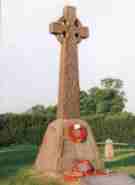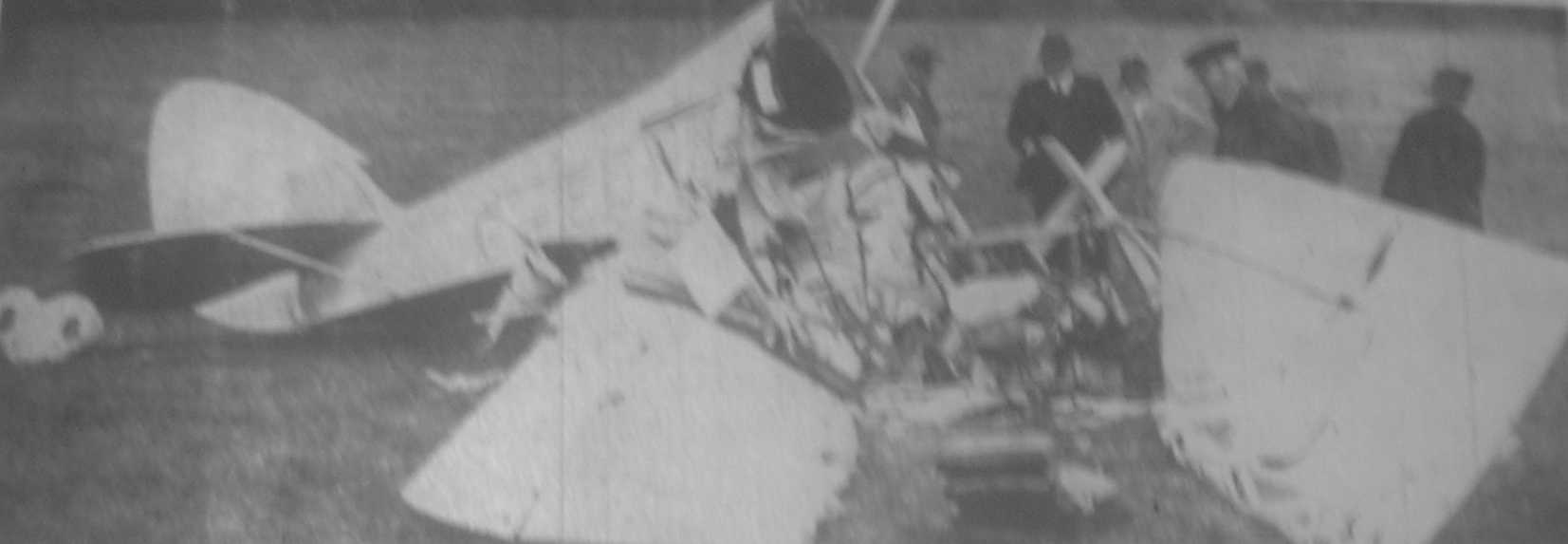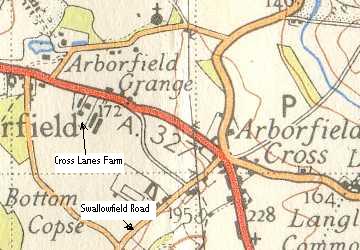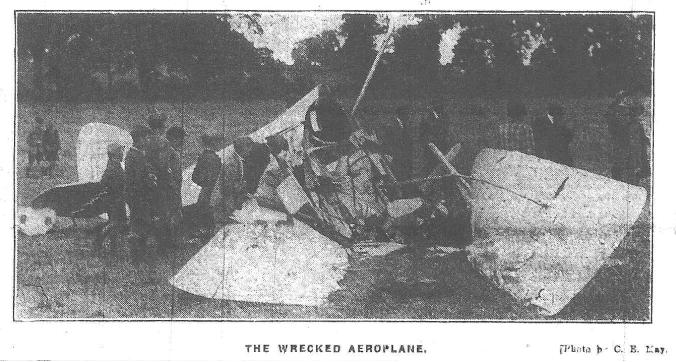
|
Arborfield
|
|
Memories
Related sites:
|
The talking point of the village in late July 1931 must have been the fatal air crash at Cross Lanes Farm on Saturday 18th at lunchtime; the 'Bull' public house served as a short-term mortuary. That year, the 'Reading Mercury' was interesting its readers in the novelty of flying, reporting on the flying circus that visited Maidenhead and running competitions where the prizes were free flights from nearby Woodley Aerodrome. In the midst of this came the appalling crash reported below. The Reading Mercury devoted many column inches to the crash and to the inquest which was held during the following week. The articles are reproduced below in full. The plane was a Gipsy Moth registered G-EBYK, similar to the one which made a forced landing at Benson that autumn to refuel at a new filling-station as shown here:
FATAL AIR CRASH NEAR READING
Two Lives Lost at Arborfield: Machine’s Dive
FLIGHT TO WEEK-END PARTY
Expert Aviators Instantly Killed: Propeller and Engine Buried A shocking air tragedy – one of the worst known in Berkshire – startled the inhabitants of Arborfield on Saturday afternoon when, while trying to land, a private two-seater aeroplane crashed into a field belonging to Mr. C. W. Crocker, of Cross Lanes Farm. The woman pilot, who was well-known in Society, and her passenger, a bank director, who was also an enthusiastic flyer, were killed instantly; both receiving terrible injuries. The victims were:
The flyers were on their way to a week-end party at Mr. Noble’s house, Chisenbury Priory, Wilts., and Mrs. Noble was awaiting their arrival. The machine left Heston (London) Aerodrome at 12:30 p.m., less than half-an-hour before the tragedy, the destination being Upavon Aerodrome. Mrs. Baring and Mr. Noble were old friends, and had learned to fly at the same time, about two years ago. CHANGE IN ORIGINAL PLANS. Farm hands at work in Mr. Crocker’s premises heard the engine of the ‘plane making an unusual noise, and they saw it circling, gradually getting lower. Suddenly the nose of the machine dropped and it dived to the ground behind a tall hedge. The propeller and engine were buried about 2 ft. in the ground, the tail being pointed almost straight up in the air. Petrol rushed out of the shattered tank, but no fire followed, which was no doubt due, according to witnesses, to the engine having been shut off immediately before the ‘plane dived.
INSTANT DEATH. Those who rushed to the scene found Mrs. Baring, who was occupying the rear cockpit seat, sitting strapped in her seat, dead. The tail of the machine had to be pulled down before she could be lifted out. Mr. Noble had been thrown forward onto the engine, and parts of the machine had to be broken away in order to extricate him. Beyond all doubt death must have occurred instantly. The identity of Mrs. Baring was established by means of her pilot’s certificate and an international motoring licence, which were found in a pocket in the machine, but it was necessary to get in touch with the aerodrome at Heston before the name of Mr. Noble could be found. With the house-party which had been assembled at Chisenbury Priory, Mrs. Noble was awaiting her husband and Mrs. Baring. As soon as the news of the accident reached her, Mrs. Noble motored to Arborfield and identified her husband. “It was simply an act of God that Mrs. Baring and my husband should have been in the same machine together”, she said. “The original plan was that Mr. Turner, a friend of Mrs. Baring, should fly in her machine, and that my husband should fly in his own machine. However, a fault was found in the petrol feed of Mr. Noble’s aeroplane, and as he was anxious not to be late for lunch he took Mr. Turner’s place in Mrs. Baring’s machine”. OWNED TWO PLANES. Mr. Noble was a most enthusiastic pilot and about 18 months ago he had a remarkable escape from death when flying at Heston, his machine crashing, but only bruises were received be him. Mrs. Baring, who had also a great amount of flying experience, had never been involved in an air accident. Besides having a ‘plane at Heston, Mr. Noble kept another on in Northumberland. He was educated at Eton and Oxford, and, in addition to his connection with Lloyds Bank, he was a director of the National Bank of Scotland. In 1895 he married Mabel, the second daughter of Percy Graham Buchanan Westmacott, formerly of Rose Mount, Ascot, and had two sons and two daughters. Mrs. Baring lived with her nine-year-old daughter. For some time no one had the courage to break the news to the child, but at last she had to be told. Mrs. Barings’ housekeeper said that after she had explained as gently as she could that the girl’s mother was dead, the child would not leave her and followed her about pathetically asking for more details. The bodies were first taken to The Bull at Arborfield. The same evening they were removed to the private mortuary of Messrs. Heelas at Wokingham. INQUEST OPENED. EVERYTHING IN ORDER BEFORE MACHINE LEFT. The inquest was opened by the Reading Divisional Coroner (Mr. R. S. Payne) at Wokingham town Hall on Monday, when only evidence of identification and medical testimony was taken. Major Cooper, the inspector-general of accidents to the Air Ministry, sat with the coroner, and the relatives of Mrs. Baring were represented by Mr. Norman Matthews (solicitor). In answer to the coroner, the jury intimated that they did not wish to see the bodies. “I am here to help you in any way”, Major Cooper told the coroner. “I could give evidence up to a point”, he added. “My duty is to make an inquiry and report to the Secretary of State for Air”. EXPERT FLYERS. The coroner remarked that they were fortunate in having the assistance of Major Cooper. “Obviously there has not been time to investigate all the circumstances”, said the coroner, “and an adjournment will be necessary. The only evidence of the occurrence is that of people in the neighbourhood, but at the adjourned hearing we can have technical evidence from people at the aerodrome from which the ‘plane started. Both the people who had lost their lives were expert flyers, holding flying certificates, and apparently they had done a great deal of flying, but whether in this machine or not I do not know”. Evidence for the identity of Mr. Noble was given by his wife, Mrs. Mabel Noble, who was dressed in deep mourning. She said she lived at Chisenbury Priory, Wilts., and her husband had been accustomed to pilot aeroplanes, having held a pilot’s certificate for over two years. She last saw her husband about a fortnight ago, and had expected him to come to Marlborough by air on Saturday. In answer to Mr. Matthews, Mrs. Noble said that it was only since the accident that she had learned that her husband had just completed negotiations with Mrs. Baring for the purchase of her machine. Mrs. Baring was going to stay at Marlborough, and a week-end party had been arranged, Mrs. Barings’ room having already been prepared. When Mrs. Noble had concluded her evidence, Councillor F. S. Perkins (who was the foreman of the jury) expressed the jury’s sympathy with her. “I thank you very, very deeply”, she replied. FIANCE’S EVIDENCE The next witness was Mr. John Denis Turner, of 8, John Street, Mayfair, and he said he identified the body of Mrs. Baring. The coroner: Was she divorced? – Yes. Mr. Matthews: She divorced her husband. Supt. Goddard: There is a difference. The coroner: What was his name? “Richard”, replied Mr. Turner, who continued that Mrs. Baring lived at Earls Court Square. The coroner: She had a flying certificate for all purposes? – Yes, an “A” licence. Major Cooper: That is generally called a pilot’s licence. Mr. Turner said that he saw Mrs. Baring leave Heston Aerodrome in a De Havilland “Moth” two-seater machine. Mr. Noble was her passenger, and there was no doubt that she was the pilot, the controls for his seat having been disconnected. The destination of the machine was Upavon Aerodrome. The coroner: Did she seem in good health and spirits on leaving? – Yes. Did she start all right? – Yes; there was an excellent take-off. I understand this machine had just been purchased from Mrs. Baring. Was it a new machine? – No; it was built in 1930. She was quite used to flying it? – Yes, she had been flying it the week-end before. Was the weather all right for flying? – Yes, the weather was perfectly normal. A CAREFUL PILOT. The certificate of airworthiness of the machine had been renewed last September, continued witness. It would take about half-an-hour to get to Wokingham from Heston. The machine was one commonly used by two people. Major Cooper: It was licensed to carry two. Mr. Matthews: You have flown with Mrs. Baring on several occasions? – Yes. In fact you were engaged to be married to her? – Yes. Would you describe her as a careful pilot? – Yes. Major Cooper said he would like to put certain questions to Mr. Turner, and on receiving the coroner’s permission asked: Did the pilot say anything to you about breaking her journey in order to land at Woodley, near Reading, or anywhere else? Witness: No. She knew Woodley Aerodrome quite well? – Yes. Woodley is quite near, and she would have no difficulty in seeing it? – That is so. Was any luggage carried? – Two suitcases in the back locker. “The position in which luggage is carried is of importance”, remarked Major Cooper. Dr. E. F. Smith, the Wokingham police surgeon, said he went to the scene of the crash at 1:10 p.m., and when he arrived Mr. Noble’s body was being extricated from the wreckage. The injuries were very extensive, the cause being head injuries received by coming into contact with the windscreen. The doctor was describing the numerous injuries, when the coroner intervened, remarking, “I do not think it is necessary for the doctor to go into details. Mr. Noble was practically smashed to bits”. NO QUESTION OF HEART ATTACK. Dr. Smith said he considered that Mrs. Baring was killed instantly owing to the injuries she had received to her head. On my order you made a post mortem examination? – yes. Did you find anything which might make her lose control? – No. Her heart and lungs were normal? Yes; there was no question of a heart attack. The doctor added that when the crash occurred Mrs. Baring’s head struck the back of Mr. Noble’s seat. “Was Mrs. Baring wearing suitable flying clothes?” inquired Major Cooper. “Yes, she was wearing a flying suit”, replied Dr. Smith. Major Cooper: Nothing in the way of a skirt which would have fouled the controls? – No. The coroner enquired when a resumption of the enquiry would be convenient, and Major Cooper said a short adjournment would be preferable. “There is a certain amount of satisfaction in knowing that death came instantly and that no pain occurred”, said the coroner, “but what the sensation was immediately before the crash I would not like to say”. INQUIRY BY AIR MINISTRY. In answer to enquiries as to the nature of the evidence to be called at the adjourned hearing, Supt. Goddard said that evidence would be called from the aerodrome to say that everything was in order before the machine left the ground. “We cannot go into the suitability of the machine; the Air Ministry will do that”. The coroner adjourned the enquiry until 2 p.m. yesterday (Friday), at the Police Court.
[On a separate page of the same edition:]
ARBORFIELD AIR DISASTER
Verdict of Accidental Death The inquest on the two victims of the flying accident at Arborfield on Saturday was concluded yesterday at Wokingham by the Coroner (Mr. R. S. Payne). John Joseph Parkes, a sales manager, of Heston Aerodrome, said he tested the machine two days before the fatality and found it in perfect order. Asked why a parachute was not carried, he said parachutes were expensive and really unnecessary for private aircraft, which were not likely to break up in the air. With Service machines the conditions were different. A parachute was not of much use below 1,500 feet. Mrs. Phyllis Windsor, of Swallowfield Road, Arborfield, who saw the crash, said the machine was about to make an easy landing, when it suddenly nose-dived to the earth.
MRS. BARING FAINTED. Captain Valentine Henry Baker, chief instructor at Heston Aerodrome, said he was with the machine when the engine was started and it ran perfectly. The take-off was a careful one. The coroner: You actually taught Mrs. Baring? – Yes, in September 1929. She flew solo after 12 hours’ instruction. She was a very careful pilot and often came back for further instruction. I last flew with her in June of this year. Asked by the Coroner if he had formed any theory how the crash happened, he replied: “I have seen the machine and in my considered opinion Mrs. Baring fainted or at least felt very ill and at the last moment she pushed the control stick forward to prevent ‘stalling’. That would have the effect of pushing the machine straight into the ground. It is not possible with this type of machine, fitted with safety slots, for the machine to dive into the ground in the position it did from an accidental stall. Since the crash I have carried out experiments with a similar type of machine with a view to seeing if it would dive into the ground in a similar position, and it can’t be done accidentally”. “I think she felt ill and intended to land. If she had left the controls alone the machine would have come down and been smashed up, but no-one would have been hurt. She was a very good pilot, and her instinct, if she felt ill, would be to push the stick forward.” Major P. P. Cooper, Inspector-General of Accidents to the Air Ministry, said he had inspected the machine and he was satisfied no main part of the machine had broken. The engine was not running when the crash occurred and the nose of the machine had struck the ground almost at right angles. There had been petrol in the tanks and the machine was not therefore endeavouring to land from petrol shortage. The engine had been examined and no defect had been found which would have caused the crash. The jury returned a verdict of “Accidental death” in each case, and they added a rider that a recommendation should be forwarded to the proper quarter that parachutes or similar appliances for escape, should be carried in all types of civil aircraft. Had parachutes been carried in this case they thought that two valuable lives would have been saved. The coroner said he would forward the jury’s recommendations to the Director of Civil Aviation. With acknowledgements to the Reading Chronicle Series. The Reading Standard also covered the air crash in its editions of 25th July and 1st August. Its photo showed that the crash drew the interest of many boys as well as adults: With acknowledgements to Surrey and Berkshire Newspapers Ltd.
There was another forced landing at Arborfield in 1931; the plane took off again and eventually crashed spectacularly in Bracknell, but amazing without injury. Click here for further details.
|
||
|
Any Feedback or comments on this website? Please e-mail the webmaster |



